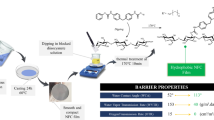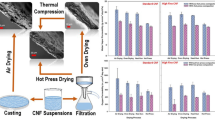Abstract
In this paper, porous nanofibrillated cellulose (NFC) films were utilized to produce water-resistant, porous cellulose films. Film porosities of ~ 50% were achieved through solvent exchange from water to acetone, and the resulting films were hydrophobized with an epoxy modifier in non-swelling conditions in acetone, yielding films that were non-wettable by water but permeable to water vapor. The mass transport mechanisms of gaseous and liquid water were studied by water vapor transfer rate (WVTR), water vapor uptake and water contact angle measurements to unfold how these properties were achieved. Surface hydrophobization was found to decrease the moisture uptake but it did not prevent it completely. The WVTR values were in effect similar for the initial and hydrophobized films, even if the water contact angles were higher in the latter. We anticipate that the porous and hydrophobic NFC films presented in this paper may find applications in sportswear, medical, or personal hygiene products.








Similar content being viewed by others
References
Aitomäki Y, Moreno-Rodriguez S, Lundström TS, Oksman K (2016) Vacuum infusion of cellulose nanofibre network composites: influence of porosity on permeability and impregnation. Mater Des 95:204–211
Alger R (1970) Proceedings of the 4th materials research symposium, Gaithersburg, MD, 26–29 Oct 1970 (Issued 1972)
Aulin C, Ahola S, Josefsson P, Nishino T, Hirose Y, Österberg M, Wågberg L (2009) Nanoscale cellulose films with different crystallinities and mesostructures their surface properties and interaction with water. Langmuir 25:7675–7685
Aulin C, Gällstedt M, Lindström T (2010) Oxygen and oil barrier properties of microfibrillated cellulose films and coatings. Cellulose 17:559–574
Barrett EP, Joyner LG, Halenda PP (1951) The determination of pore volume and area distributions in porous substances. I. Computations from nitrogen isotherms. J Am Chem Soc 73:373–380
Bedane AH, Eić M, Farmahini-Farahani M, Xiao H (2015) Water vapor transport properties of regenerated cellulose and nanofibrillated cellulose films. J Membr Sci 493:46–57
Bedane AH, Eić M, Farmahini-Farahani M, Xiao H (2016) Theoretical modeling of water vapor transport in cellulose-based materials. Cellulose 23:1537–1552
Belbekhouche S, Bras J, Siqueira G, Chappey C, Lebrun L, Khelifi B, Marais S, Dufresne A (2011) Water sorption behavior and gas barrier properties of cellulose whiskers and microfibrils films. Carbohydr Polym 83:1740–1748
Brunauer S, Emmett PH, Teller E (1938) Adsorption of gases in multimolecular layers. J Am Chem Soc 60:309–319
Ferrer A, Quintana E, Filpponen I, Solala I, Vidal T, Rodríguez A, Laine J, Rojas OJ (2012) Effect of residual lignin and heteropolysaccharides in nanofibrillar cellulose and nanopaper from wood fibers. Cellulose 19:2179–2193
Henriksson M, Berglund LA, Isaksson P, Lindstrom T, Nishino T (2008) Cellulose nanopaper structures of high toughness. Biomacromolecules 9:1579–1585
Hill CA, Norton A, Newman G (2009) The water vapor sorption behavior of natural fibers. J Appl Polym Sci 112:1524–1537
Hubbe MA, Rojas OJ, Lucia LA, Sain M (2008) Cellulosic nanocomposites: a review. BioResources 3:929–980
Jiang F, Hsieh Y (2014) Amphiphilic superabsorbent cellulose nanofibril aerogels. J Mater Chem A 2:6337–6342
Kontturi KS, Biegaj KW, Mautner A, Woodward RT, Wilson BP, Johansson L, Lee K, Heng JY, Bismarck A, Kontturi E (2017) Non-covalent surface modification of cellulose nanopapers by adsorption of polymers from aprotic solvents. Langmuir 33(23):5707–5712
Kulasinski K, Guyer R, Derome D, Carmeliet J (2015) Water adsorption in wood microfibril-hemicellulose system: role of the crystalline–amorphous interface. Biomacromolecules 16:2972–2978
Larsson M, Johnsson A, Gårdebjer S, Bordes R, Larsson A (2017) Swelling and mass transport properties of nanocellulose-HPMC composite films. Mater Des 122:414–421
Lavoine N, Desloges I, Dufresne A, Bras J (2012) Microfibrillated cellulose–its barrier properties and applications in cellulosic materials: a review. Carbohydr Polym 90:735–764
Nechyporchuk O, Belgacem MN, Bras J (2016) Production of cellulose nanofibrils: a review of recent advances. Ind Crops Prod 93:2–25
Nechyporchuk O, Yu J, Nierstrasz VA, Bordes R (2017) Cellulose nanofibril-based coatings of woven cotton fabrics for improved inkjet printing with a potential in e-textile manufacturing. ACS Sustain Chem Eng 5(6):4793–4801
Niinivaara E, Faustini M, Tammelin T, Kontturi E (2016) Mimicking the humidity response of the plant cell wall by using two-dimensional systems: the critical role of amorphous and crystalline polysaccharides. Langmuir 32:2032–2040
Österberg M, Vartiainen J, Lucenius J, Hippi U, Seppälä J, Serimaa R, Laine J (2013a) A fast method to produce strong NFC films as a platform for barrier and functional materials. ACS Appl Mater Interfaces 5:4640–4647
Österberg M, Peresin MS, Johansson L, Tammelin T (2013b) Clean and reactive nanostructured cellulose surface. Cellulose 20:983–990
Pääkkö M, Ankerfors M, Kosonen H, Nykänen A, Ahola S, Österberg M, Ruokolainen J, Laine J, Larsson PT, Ikkala O (2007) Enzymatic hydrolysis combined with mechanical shearing and high-pressure homogenization for nanoscale cellulose fibrils and strong gels. Biomacromolecules 8:1934–1941
Paul UC, Fragouli D, Bayer IS, Mele E, Conchione C, Cingolani R, Moret S, Athanassiou A (2017) Mineral oil barrier sequential polymer treatment for recycled paper products in food packaging. Mater Res Express 4:015501
Pour G, Beauger C, Rigacci A, Budtova T (2015) Xerocellulose: lightweight, porous and hydrophobic cellulose prepared via ambient drying. J Mater Sci 50:4526–4535
Rodionova G, Lenes M, Eriksen Ø, Gregersen Ø (2011) Surface chemical modification of microfibrillated cellulose: improvement of barrier properties for packaging applications. Cellulose 18:127–134
Rojo E, Peresin MS, Sampson WW, Hoeger IC, Vartiainen J, Laine J, Rojas OJ (2015) Comprehensive elucidation of the effect of residual lignin on the physical, barrier, mechanical and surface properties of nanocellulose films. Green Chem 17:1853–1866
Saito T, Nishiyama Y, Putaux J, Vignon M, Isogai A (2006) Homogeneous suspensions of individualized microfibrils from TEMPO-catalyzed oxidation of native cellulose. Biomacromolecules 7:1687–1691
Saito T, Kimura S, Nishiyama Y, Isogai A (2007) Cellulose nanofibers prepared by TEMPO-mediated oxidation of native cellulose. Biomacromolecules 8:2485–2491
Sehaqui H, Zimmermann T, Tingaut P (2014) Hydrophobic cellulose nanopaper through a mild esterification procedure. Cellulose 21:367–382
Spence KL, Venditti RA, Habibi Y, Rojas OJ, Pawlak JJ (2010a) The effect of chemical composition on microfibrillar cellulose films from wood pulps: mechanical processing and physical properties. Bioresour Technol 101:5961–5968
Spence KL, Venditti RA, Rojas OJ, Habibi Y, Pawlak JJ (2010b) The effect of chemical composition on microfibrillar cellulose films from wood pulps: water interactions and physical properties for packaging applications. Cellulose 17:835–848
Tammelin T, Abburi R, Gestranius M, Laine C, Setälä H, Österberg M (2015) Correlation between cellulose thin film supramolecular structures and interactions with water. Soft Matter 11:4273–4282
Wågberg L, Decher G, Norgren M, Lindström T, Ankerfors M, Axnäs K (2008) The build-up of polyelectrolyte multilayers of microfibrillated cellulose and cationic polyelectrolytes. Langmuir 24:784–795
Acknowledgments
The VINN Excellence Centre SuMo Biomaterials is gratefully acknowledged for financial support. The authors also acknowledge Anders Mårtensson for skillful SEM work and Anne Wendel for support in the BET measurements. Furthermore, the authors thank Prof. Gunnar Westman for fruitful discussions and Chris Bonnerup for providing the NFC.
Author information
Authors and Affiliations
Corresponding author
Electronic supplementary material
Below is the link to the electronic supplementary material.
Rights and permissions
About this article
Cite this article
Solala, I., Bordes, R. & Larsson, A. Water vapor mass transport across nanofibrillated cellulose films: effect of surface hydrophobization. Cellulose 25, 347–356 (2018). https://doi.org/10.1007/s10570-017-1608-z
Received:
Accepted:
Published:
Issue Date:
DOI: https://doi.org/10.1007/s10570-017-1608-z




